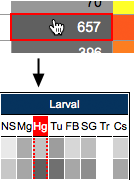FlyAtlas 2 – Gene
For a particular Drosophila gene, find the pattern of expression in different tissues.
Gene Symbol (e.g. vkg) — start typing, then select from the autosuggest menu
Gene Name (e.g. viking)
Annotation Symbol (e.g. CG16858)
Gene ID (e.g. FBgn0016075)
Transcript ID (e.g. FBtr0079036)
Gene Name (e.g. viking)
Annotation Symbol (e.g. CG16858)
Gene ID (e.g. FBgn0016075)
Transcript ID (e.g. FBtr0079036)
Gene:
| Adult Male | Adult Female | Male v. Female | Larval | |||||
|---|---|---|---|---|---|---|---|---|
| Tissue | FPKM | Enrichment | FPKM | Enrichment | M/F | p value | FPKM | Enrichment |
| Head | 0.0 ± 0.0 | N.A. | 0.0 ± 0.0 | N.A. | 1.00 | n.s. | ||
| Eye | 0.0 ± 0.0 | N.A. | 0.0 ± 0.0 | N.A. | 1.00 | n.s. | ||
| Brain / CNS | 0.0 ± 0.0 | N.A. | 0.0 ± 0.0 | N.A. | 1.00 | n.s. | 0.0 ± 0.0 | N.A. |
| Thoracicoabdominal ganglion | 0.0 ± 0.0 | N.A. | 0.0 ± 0.0 | N.A. | 1.00 | n.s. | ||
| Crop | 0.0 ± 0.0 | N.A. | 0.0 ± 0.0 | N.A. | 1.00 | n.s. | ||
| Midgut | 0.0 ± 0.0 | N.A. | 0.0 ± 0.0 | N.A. | 1.00 | n.s. | 0.0 ± 0.0 | N.A. |
| Hindgut | 0.0 ± 0.0 | N.A. | 0.0 ± 0.0 | N.A. | 1.00 | n.s. | 0.0 ± 0.0 | N.A. |
| Malpighian Tubules | 0.0 ± 0.0 | N.A. | 0.0 ± 0.0 | N.A. | 1.00 | n.s. | 0.0 ± 0.0 | N.A. |
| Rectal pad | 0.0 ± 0.0 | N.A. | 0.0 ± 0.0 | N.A. | 1.00 | n.s. | ||
| Salivary gland | 0.0 ± 0.0 | N.A. | 0.0 ± 0.0 | N.A. | 1.00 | n.s. | 0.0 ± 0.0 | N.A. |
| Fat body | 30682 ± 6605 | 15341 | 7521 ± 2529 | 3761 | 4.1 | p < 0.05 | 0.0 ± 0.0 | N.A. |
| Heart | 0.0 ± 0.0 | N.A. | 0.0 ± 0.0 | N.A. | 1.00 | n.s. | ||
| Trachea | 0.0 ± 0.0 | N.A. | ||||||
| Ovary | 0.0 ± 0.0 | N.A. | ||||||
| Virgin Spermatheca | 6195 ± 2627 | 3098 | ||||||
| Mated Spermatheca | 6505 ± 2553 | 3252 | ||||||
| Testis | 0.0 ± 0.0 | N.A. | ||||||
| Accessory glands | 0.0 ± 0.0 | N.A. | ||||||
| Carcass | 0.0 ± 0.0 | N.A. | 0.0 ± 0.0 | N.A. | 1.00 | n.s. | 0.0 ± 0.0 | N.A. |
| Garland cells | 652 ± 591 | 326 | ||||||
| Whole body | 0.0 ± 0.0 | 0.0 ± 0.0 | 1.00 | n.s. | 0.0 ± 0.0 | |||

Rotate to see Transcript Table
| Transcript | Male | Female | Larval | ||||||||||||||||||||||||||||||||||||||
|---|---|---|---|---|---|---|---|---|---|---|---|---|---|---|---|---|---|---|---|---|---|---|---|---|---|---|---|---|---|---|---|---|---|---|---|---|---|---|---|---|---|
| Name | ID | Hd | Ey | Br | Tg | Cr | Mg | Hg | Tu | Rp | Sg | Fb | Ht | Ts | Ag | Cs | Hd | Ey | Br | Tg | Cr | Mg | Hg | Tu | Rp | Sg | Fb | Ht | Ov | Vs | Ms | Cs | Ns | Mg | Hg | Tu | Sg | Fb | Tr | Cs | Ga |
| RA | FBtr0078576 | ||||||||||||||||||||||||||||||||||||||||

These data are for a snoRNA (small nucleolar RNA) that does not encode a protein.
There are two main classes of snoRNAs: 1. CD class snoRNAs, involved in rRNA methylation, which are generally not detected by our techniques as they are too small, and 2. ACC class snoRNAs, involved in pseudouridylation, which are generally large enough to be detected. (N.B. Data for Fat Body and Spermatheca may not be comparable with those from other tissues.)
There are two main classes of snoRNAs: 1. CD class snoRNAs, involved in rRNA methylation, which are generally not detected by our techniques as they are too small, and 2. ACC class snoRNAs, involved in pseudouridylation, which are generally large enough to be detected. (N.B. Data for Fat Body and Spermatheca may not be comparable with those from other tissues.)

